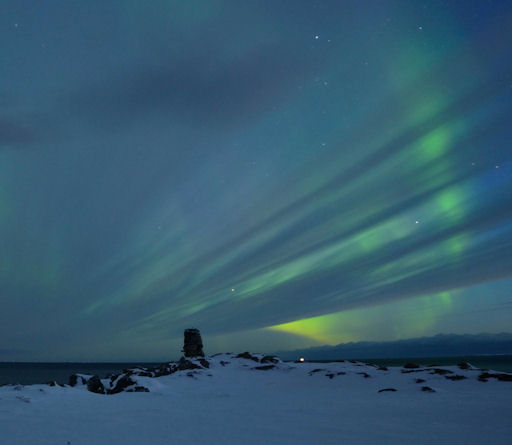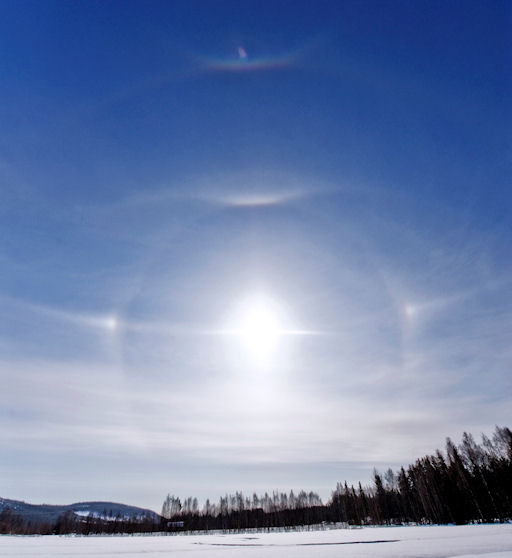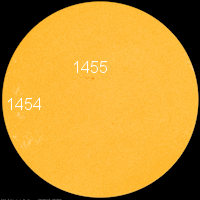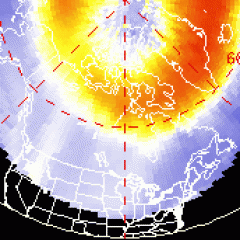~Space Weather Update~ Growing Sunspot~ Wind Speed 508 [1]
GREEN COCKPIT: Earth is entering a solar wind stream that could spark high-latitude auroras during the next 24-48 hours. The first stirrings of Northern Lights were sghted this morning over Wisconsin [2] and from the cockpit [3] of an air ambulance flight [4] over Canada. Aurora alerts: text [5], phone [6].
ARCTIC MIX: Something magical is happening around the Arctic Circle this week. The blue midnight skies of spring are intermingling with the gray snow clouds of winter--with a dash of green cutting through the mix. Anne Birgitte Fyhn photographed the phenomenon last night from Ringvassøya island, north of Tromsø, Norway:
Fyhn was on an overnight kayaking trip with friends. "This is how the sky looked just before the weather turned cloudy and a snow storm started," she says.
The midnight sun was also present. "It's just amazing to see auroras dancing across blue sky [8] with the glow of the sun on the horizon," says fellow kayaker Gunnar Hildonen. Altogether, the ensemble was a nice surprise [9], adds Harald Albrigtsen, who was there, too.
More lights are possible on April 12-14 when a high-speed solar wind stream is expected to hit Earth's magnetic field. NOAA forecasters estimate a ~20% chance of geomagnetic storms around the poles. Aurora alerts: text [5], phone [6].
more images: from Frank Olsen [10] of Blokken in Sortland, Norway; from Ole C. Salomonsen [11] of Tromsø, Norway; from Anne Fyhn [12] of Grøtfjord, Tromsø, Norway; from Harald Albrigtsen [13] of Grøtfjorden, Norway; from Sylvain Serre [14] of Ivujivik, Nunavik, Quebec, Canada; from Göran Strand [15] of Rörvattnet, Sweden;
SEVEN ICE HALOES: As spring unfolds, Arctic daylight will soon wrap all the way around the clock, chasing away midnight displays of aurora borealis. There are compensations, however, for 24-hour sunlight. It increases the odds of witnessing ice haloes around the sun. On April 4th, Fredrik Broms photographed this display over Rovaniemi, Finland
"Looking up at the sky during daytime can be rewarding," says Broms. "In the cold crisp air in Finland a beautiful ice halo display was visible a few days ago."
The luminous rays, rings, and arcs he photographed are caused by sunlight shining through ice crystals in the air. Looking carefully, Broms counted at least seven distinct ice halos around the sun: labeled image [17].
You don't have to be in the Arctic to witness displays like this. Temperatures are freezing all around the world in clouds ~10km above the ground. Sunlight shining through icy clouds can produce haloes anywhere. Browse the links for more examples: from Ivo Dinsbergs [18] of Riga, Latvia; from Heiko Ulbricht [19] of Freital, Saxony, Germany; from Juha Ojanperä [20] of Lapinjärvi, Finland.

![]()
Solar wind
speed: 508.3 km/sec
density: 2.3 protons/cm3
explanation [21] | more data [22]
Updated: Today at 1616 UT
![]()
X-ray Solar Flares
6-hr max: B3 1012 UT Apr12
24-hr: B5 0848 UT Apr12
explanation [23] | more data [24]
Updated: Today at: 1600 UT
![]()
![]()
![]()
Daily Sun: 12 Apr 12
![]()
![]()
New sunspot 1455 is crackling with low-level B-class [26] solar flares. Credit: SDO/HMI
![]()
![]()
![]()
Sunspot number: 28
What is the sunspot number? [27]
Updated 12 Apr 2012
Spotless Days
Current Stretch: 0 days
2012 total: 0 days (0%)
2011 total: 2 days (<1%)
2010 total: 51 days (14%)
2009 total: 260 days (71%)
Since 2004: 821 days
Typical Solar Min: 486 days
Updated 12 Apr 2012
The Radio Sun
10.7 cm flux: 93 sfu
explanation [28] | more data [29]
Updated 12 Apr 2012
![]()
![]()
![]()
Current Auroral Oval:
![]()
Switch to: Europe, USA, New Zealand, Antarctica
Credit: NOAA/POES
![]()
![]()
![]()
Planetary K-index
Now: Kp= 2 quiet
24-hr max: Kp= 3 quiet
explanation [31] | more data [32]
![]()
Interplanetary Mag. Field
Btotal: 8.4 nT
Bz: 6.2 nT south
explanation [33] | more data [34]
Updated: Today at 1617 UT
![]()
![]()
![]()
Coronal Holes: 12 Apr 12
![]()
![]()
Solar wind flowing from this coronal hole should reach Earth on April 13-14. Credit: SDO/AIA.
Category:
- Ground Crew Updates [37]




